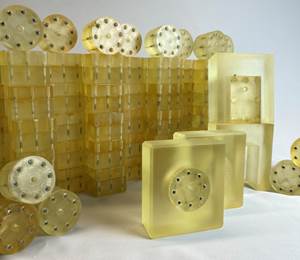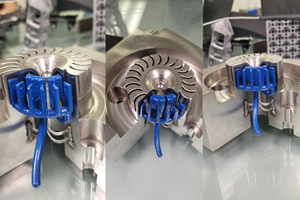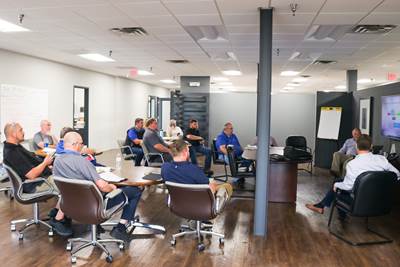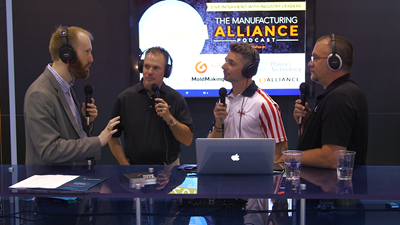Siemens, EOS North America Partner to Improve AM Efficiency, Profitability
Combination of EOS machines and Siemens AM software to provide customers opportunity for a seamless, automated AM digital thread from design through production.
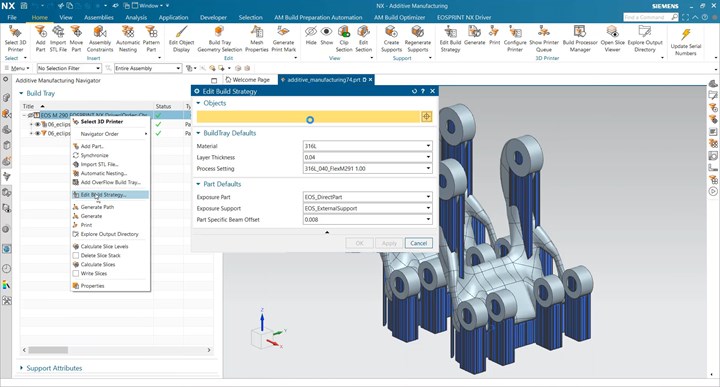
The integration of NX AM software with EOS’ job and process management software EOSPRINT 2 enables users to generate EOS build files directly in NX, defining material, exposure sets, and beam offset values, among other variables. All photo credit: Siemens
Siemens Digital Industries Software (Plano, Texas) and EOS North America (Novi, Michigan) announced on Feb. 23 an expanded partnership, with a goal to help improve efficiency and profitability and increase the adoption of industrialized additive manufacturing (AM). Through this agreement, EOS North America, a technology provider for industrial metal and polymer 3D printing, will be able to resell Siemens’ software solutions for AM with its machines. According to both companies, this can provide customers with build preparation and build optimization, as well as connectivity to critical upstream design and downstream production processes.
“The ability to offer our customers a combination of Siemens’ AM software with EOS machines is an important step toward industrializing AM for larger-scale production,” says Andrew Snow, senior vice president of EOS North America. “We want to ensure that our customers can be as successful printing their first part today as they will their ten-thousandth part tomorrow, which means our machines must go beyond build preparation to connect to the entire end-to-end AM process. This new agreement with Siemens will help accomplish this and we’re excited to partner with Siemens as a reseller of their AM solutions.”
In addition to integrating EOS’ job and process management software EOSPRINT 2 with Siemens’ NX software, EOS will begin to resell NX AM build preparation and its AM Build Optimizer software for part orientation and support structure optimization to metal additive customers. The combined capabilities of these solutions can reportedly give EOS customers greater confidence that they’ve prepared their 3D-printed parts to best accomplish their goals of first-time-right printing. In addition, the combination of EOS and Siemens solutions will allow EOS customers to leverage other Siemens capabilities across the AM digital thread, including design for additive, topology optimization, build process simulation, materials engineering and durability analysis, design validation, scheduling and execution, process automation, performance monitoring and product lifecycle management (PLM).
Siemens and EOS have a longstanding partnership in advancing industrialized AM, which began in 2016, when EOS integrated its EOSPRINT software into Siemens’ NX software, and was extended in 2018, when Siemens provided automation and drive technology for the new EOS M 300 Series and EOS P 500 Series machines. This new agreement further expands this partnership by enabling EOS North America to resell products in Siemens’ end-to-end solution for industrialized AM as part of its Xcelerator portfolio of software and services.
“With this agreement, EOS and Siemens can greatly improve the efficiency and profitability of the AM factory,” adds Aaron Frankel, vice president of the AM Program for Siemens Digital Industries Software. “Instead of only providing the build preparation for a single machine, customers can now leverage a unified process upstream to transform design, and downstream to realize high-volume AM factory production. This unified process is critical for industrialized AM.”
It is said that the difference between Siemens’ end-to-end additive design-through-manufacturing environment and point solution alternatives is that every phase of the AM development is connected via a single, associative digital thread. “Point solutions introduce time-consuming, error-prone inefficiencies into the AM workflow,” says Frankel. “Customers often have to interrupt their process to convert data for different software environments. And the problems with this approach are compounded with every change that’s required.”
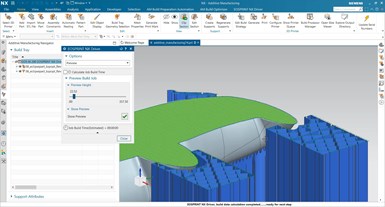
According to Andrew Snow, the senior vice president of EOS North America, the integration of Siemens software and EOS hardware, will help users “be as successful printing their first part today as they will their ten-thousandth part tomorrow.” After defining their build strategy in NX, users can also get previews of the layer-by-layer hatching pattern of their EOS-printed parts before they generate the files for EOSPRINT.
As an example, Sintavia LLC (Fort Lauderdale, Florida), a designer and additive manufacturer of critical thermal components for the aerospace, defense and space industry, has been building an end-to-end additive manufacturing workflow leveraging the NX AM Print Driver for EOSPRINT and NX AM Build Preparation and AM Build Optimizer. The company also recently purchased two M4K-4 printers which are stretched versions of the EOS M400-4 printer. “This move by EOS North America to more tightly integrate Siemens AM software into its 3D printing systems perfectly aligns with our goal to create a seamless automated AM digital thread from design through production,” says Brian Neff, CEO of Sintavia. “If we’re going to make AM a truly industrialized process, we need to ensure that the entire workflow is as efficient as possible. A strong technical integration between EOS and Siemens software not only helps with build preparation, optimization and 3D printing, but it enables tighter connection to every other phase across the AM value chain.”
As part of the reseller agreement, Siemens Digital Industries Software will train the EOS Additive Minds technical consulting team on NX AM and AM Build Optimizer software. Additive Minds, in turn, will train EOS customers on the use of Siemens’ AM solutions. The two organizations have also agreed on an extensive framework for providing in-depth technical support.
Related Content
In "Hybrid" FIM Process, 3D Printing Complements Injection Molding
Alpine Advanced Materials used a desktop 3D printer and the freeform injection molding process to reduce prototype tooling production time and cost for its customers.
Read MoreBuilding Molds: Most Popular Reads of 2024
Dive into the most-viewed content for building your mold, including topics such as cutting tools, EDM, hot runners, additive manufacturing, mold materials, machining and mold components.
Read MoreA 3D Printing Retrospective
A personal review of the evolution of 3D printing in moldmaking throughout the past 25 years.
Read MoreLarge Hybrid Steel Insert Solves Deformation, Dimensionality, Cycle Time Problems
DMLS printers using metal additive powders selected by Linear AMS to produce high-quality, accurate, consistent 3D-printed mold components with certification and traceability.
Read MoreRead Next
Taking Care of the People Side of an Acquisition
Focusing on the human side of the business—employee health, safety, success and growth—is the only way to satisfy both the buyer and seller.
Read MorePodcast: Trends, Benefits of Metal AM for Moldmaking
An episode of the Manufacturing Alliance podcast recorded live at NPE2018 features industry experts discussing who benefits from using additive manufacturing in moldmaking and which AM trends are helping moldmakers.
Read MoreReasons to Use Fiber Lasers for Mold Cleaning
Fiber lasers offer a simplicity, speed, control and portability, minimizing mold cleaning risks.
Read More
















